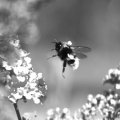An outstanding research achievement by University of Queensland PhD student Jim Gibbs is expected to boost bottom line profits for northern Australia beef producers.
His work in analysing the feed intake of cattle has also been recognised with a prestigious national science award.
Mr Gibbs has extended the use of near infrared spectroscopy (NIR) from a pasture diet to include a range of feed supplements commonly used in north Australia.
Analysing faeces samples, a set of equations has been developed to predict the combined feed value of grazing with typical supplements such as barley, cottonseed meal or urea.
Mr Gibbs’ supervisor, Associate Professor Dennis Poppi of the School of Land and Food Sciences, said the research had extended the application of NIR technology to the grazing industry of northern Australia.
"Sourcing feeds from across the north and developing new equations to predict the quality of a mixed diet has been a major advance," Associate Professor Poppi said.
Mr Gibbs has worked closely with leading scientists Dr David Coates of CSIRO in Townsville and ruminant nutritionists Rob Dixon and Stuart McLennan of the Department of Primary Industries at Yeerongpilly, Brisbane.
He presented a paper on his work with Dr Coates at the 10th National NIRS Conference in Coffs Harbour and won the Lynsey Anne Welsh Award for innovation in NIR science.
"NIR technology is used across a whole range of industries and it was good for its value to animal nutrition to be recognised," Mr Gibbs said.
Mr Gibbs completed a veterinary science degree at the University of Queensland and practised in Australia and overseas for seven years before embarking on full-time PhD study. Much of his work has been at the UQ research farm at Mt Cotton with laboratory analysis of samples carried out in Townsville.
"Supplementary feeding is now a vital part of the northern cattle industry,” he said.
“Providing accurate predictions on nutritional value and digestibility will prove extremely valuable.
“Fine tuning the diet can help reduce wastage and improve feeding efficiency. With the big numbers of livestock, the financial benefits can be very significant.
"It has been a painstaking process analysing samples to develop the equations, but there should be long-term benefits."
University and Australian Research Council awards and a grant from Meat and Livestock Australia have supported his study.
He has now secured a UQ Graduate Research Travel Award to visit the United States in November and work with NIR technology pioneer Dr Jerry Struth at Texas A&M University.
Media: For more information, contact Dennis Poppi (telephone 07 3365 2573) or Jim Gibbs (telephone 0410 415 931).



